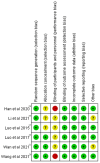Efficacy and Safety of High-Voltage Pulsed Radiofrequency versus Standard-Voltage Pulsed Radiofrequency for Patients with Neuropathic Pain: A Literature Review and Meta-Analysis
- PMID: 38464903
- PMCID: PMC10922952
- DOI: 10.2147/JPR.S439909
Efficacy and Safety of High-Voltage Pulsed Radiofrequency versus Standard-Voltage Pulsed Radiofrequency for Patients with Neuropathic Pain: A Literature Review and Meta-Analysis
Abstract
Background: Neuropathic pain (NP) is recognized as one of the most difficult pain syndromes which lacks a safe, well-tolerated and effective treatment. Pulsed radiofrequency (PRF), a novel and minimally invasive interventions, has been introduced to alleviate various types of NP. Previous studies reported PRF with higher voltage could further improve the treatment efficacy. Therefore, we conducted this systematic review and meta-analysis to determine whether high-voltage PRF is superior to standard-voltage PRF for the treatment of NP patients.
Methods: Databases published from the date of inception until 15 March 2022 on PubMed/MEDLINE, EMBASE, Web of Science and the Cochrane Library were searched for RCTs comparing high-voltage PRF and standard-voltage PRF in NP patients. The primary outcome measures were the efficiency rates of NP patients with high-voltage PRF or standard-voltage PRF treatment. Data analysis was conducted using the Review Manager software (RevMan V.5.3).
Results: Six RCTs involving 423 patients were included in our meta-analysis. Compared with standard-voltage PRF group, the high-voltage PRF group attained a higher efficiency rate at 1 month (P = 0.04; I2 = 0%), 3 months (P = 0.04; I2 = 0%), 6 months (P = 0.002; I2 = 0%) post-procedure respectively. There was no significant difference in the complications between the two groups.
Conclusion: Our study supported that high-voltage PRF attained more satisfactory efficacy than standard-voltage PRF without increased side effects. High-voltage PRF could be a promising, effective, minimally invasive technology for NP patients.
Keywords: efficacy; high-voltage; pulsed radiofrequency; standard-voltage; trigeminal neuralgia.
© 2024 Wang et al.
Conflict of interest statement
The authors declare that they have no competing interest in this work.
Figures








Similar articles
-
Efficacy and safety of high-voltage versus standard-voltage pulsed radiofrequency ablation for patients with neuropathic pain: protocol for a systematic review and meta-analysis.BMJ Open. 2022 Jul 8;12(7):e063385. doi: 10.1136/bmjopen-2022-063385. BMJ Open. 2022. PMID: 35803629 Free PMC article.
-
Treatment of Neuropathic Pain Using Pulsed Radiofrequency: A Meta-analysis.Pain Physician. 2016 Sep-Oct;19(7):429-44. Pain Physician. 2016. PMID: 27676660
-
Long-term Follow-up of the Effectiveness and Safety of High-voltage Pulsed Radiofrequency Treatment for Infraorbital Neuralgia: A Retrospective Study.Pain Physician. 2024 Sep;27(7):E751-E759. Pain Physician. 2024. PMID: 39353123
-
Efficacy of High-Voltage Pulsed Radiofrequency in Zoster-Associated Pain: A Meta-Analysis and Systematic Review.Anesthesiol Res Pract. 2023 Dec 23;2023:8479293. doi: 10.1155/2023/8479293. eCollection 2023. Anesthesiol Res Pract. 2023. PMID: 38162190 Free PMC article. Review.
-
Efficacy of Pulsed Radiofrequency Stimulation in Patients with Peripheral Neuropathic Pain: A Narrative Review.Pain Physician. 2018 May;21(3):E225-E234. Pain Physician. 2018. PMID: 29871378 Review.
Cited by
-
Ultrasound-guided high-voltage pulsed radiofrequency versus standard-voltage pulsed radiofrequency in refractory chronic cervical radicular pain randomized clinical trial.J Anesth. 2025 Jul 5. doi: 10.1007/s00540-025-03535-5. Online ahead of print. J Anesth. 2025. PMID: 40617971
-
Efficacy of Epidural Pulsed Radiofrequency Treatment in Persistent Spinal Pain Syndrome: A Prospective Clinical Study.Pain Res Manag. 2025 Apr 11;2025:6200102. doi: 10.1155/prm/6200102. eCollection 2025. Pain Res Manag. 2025. PMID: 40255928 Free PMC article. Clinical Trial.
-
Comment on: "Pulsed radiofrequency treatment for the management of trigeminal neuropathic pain".Saudi J Anaesth. 2025 Jul-Sep;19(3):455-456. doi: 10.4103/sja.sja_67_25. Epub 2025 Jun 16. Saudi J Anaesth. 2025. PMID: 40642614 Free PMC article. No abstract available.
-
High-voltage pulsed radiofrequency of the suprascapular nerve for the treatment of chronic shoulder pain.PM R. 2025 Jul;17(7):865-867. doi: 10.1002/pmrj.13319. Epub 2025 Jan 13. PM R. 2025. PMID: 39803926 Free PMC article. No abstract available.
References
Publication types
LinkOut - more resources
Full Text Sources
Miscellaneous

